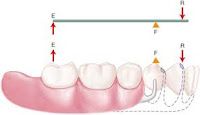Indirect retainers in RPD mostly needed:
B- class II
C- class III
D- class IV
Used in class I,II,IV.
Indirect retainers:
They are metallic elements that prevent the displacement of the prosthesis.
Function:
Prevent the interlocking of the prosthesis.
Stabilize the prosthesis in the horizontal plane.
Distribute on the support teeth the pressures that act on the base during chewing.
Transmit occlusal forces parallel to the major axis of the support teeth
Types of indirect retainers:
- Occlusal stops.
- Coronary bar.
- Cingular bar.
1- Occlusal stops:
They are cast metal elements, which rest on the occlusal face of the teeth.
They are usually located in molars and premolars and, failing that, they can be placed in canines and incisors
Its shape depends on the tooth on which they rest.
In the support pieces you have to prepare a pit in the enamel so that they do not produce interference
2- Cingular bar:
It is a metallic element that rests on the cingule of the previous pieces.
Its section is shaped like a half cane.
Its dimensions are 2 mm high x 1 mm thick.
Its function is to oppose the displacements of the prosthesis in the sagittal plane.
It can be associated with occlusal stops to reinforce its effect.
3- Coronary bar:
It is the same as the cingular bar, but is located in the third of the occlusal face of molars and premolars.
Its dimensions are the same as those of the cingular bar.
Its function is to oppose the movements of the prosthesis in the horizontal plane and is used as a reciprocal element of some retainers.
